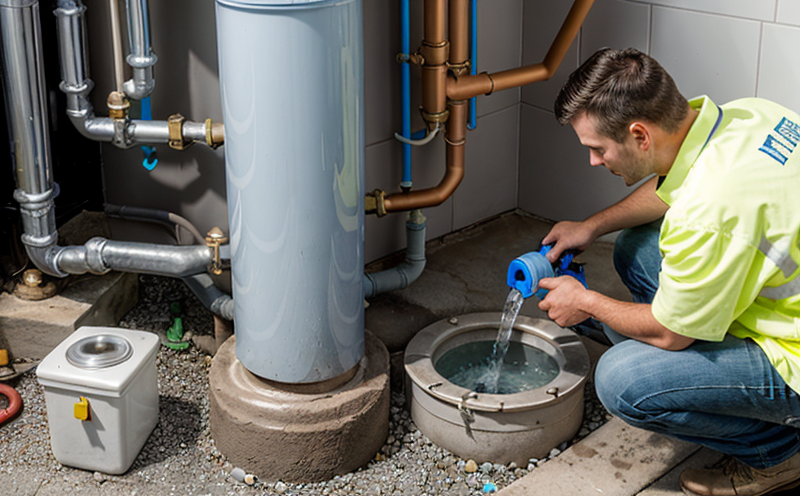EN 12201-5 Testing of Installation Joints
The EN 12201-5 standard provides a comprehensive framework for the testing of installation joints in plumbing and water systems. These joints are critical components that ensure the integrity, durability, and safety of plumbing installations by preventing leaks and maintaining hygienic standards.
The primary focus of this standard is to ensure that installation joints meet specific performance criteria under various loading conditions. The test procedures described in EN 12201-5 are designed to evaluate the joint's resistance to internal pressure, external loads, and other environmental factors that could compromise its integrity over time.
Quality managers and compliance officers play a crucial role in ensuring that these joints adhere to international standards like ISO 4837-1:2016 or EN 15979. This service ensures that installations meet the highest safety and performance levels, which is particularly important in sectors such as building construction, infrastructure development, and water treatment facilities.
The testing process involves subjecting specimen joints to defined loading conditions, including hydraulic pressure tests and mechanical load tests. Compliance officers must ensure that the specimens used for testing are representative of real-world applications. This includes using appropriate materials and dimensions that accurately reflect the intended use in plumbing systems.
R&D engineers benefit from this service by gaining insights into material behavior under stress and identifying potential improvements in design or manufacturing processes. They can also leverage test results to validate new product formulations or innovative joint designs. For procurement professionals, adhering to these standards helps in selecting suppliers who deliver high-quality materials and components.
The EN 12201-5 testing process typically involves several key steps:
- Selection of appropriate specimen joints based on intended use
- Preparation of test specimens to ensure they are free from defects
- Application of hydraulic pressure to simulate operational conditions
- Application of mechanical loads to evaluate joint performance under stress
- Data collection and analysis using precise instrumentation
- Evaluation against acceptance criteria specified in the standard
The testing apparatus used for this process includes hydraulic presses, load frames, pressure gauges, displacement sensors, and other specialized equipment. The data collected is then analyzed to determine whether the joints meet the performance requirements outlined in EN 12201-5.
Compliance with these standards helps ensure that plumbing installations are safe and reliable, reducing the risk of leaks and contamination. This not only enhances public safety but also minimizes maintenance costs associated with premature failures or repairs due to substandard materials or poor design practices.
Scope and Methodology
The scope of EN 12201-5 covers the testing procedures for installation joints used in plumbing systems. This includes both static and dynamic tests to assess the joint's ability to withstand various loading conditions.
The methodology involves a series of defined steps aimed at ensuring that the joints perform as intended under real-world scenarios. These steps include:
- Selection of appropriate test specimens
- Application of hydraulic pressure to simulate operational conditions
- Application of mechanical loads to evaluate joint performance under stress
- Data collection using precise instrumentation
- Evaluation against acceptance criteria specified in the standard
The test specimens used for this process are carefully prepared to ensure they are free from defects and representative of real-world applications. This includes selecting materials and dimensions that accurately reflect the intended use in plumbing systems.
Hydraulic pressure tests are conducted using specialized equipment designed to apply controlled amounts of pressure to the joints. These tests assess the joint's ability to maintain integrity under specified internal pressures, which simulate operational conditions.
Mechanical load tests are carried out using load frames and displacement sensors to evaluate the joint's performance under external loads. This helps determine whether the joint can withstand the stresses it may encounter during installation or in use.
Data is collected throughout the testing process using a variety of instruments, including pressure gauges, displacement sensors, and other specialized equipment. This data is then analyzed to ensure that the joints meet the performance requirements specified in EN 12201-5.
Industry Applications
The testing of installation joints as per EN 12201-5 finds application across various sectors, including building construction, infrastructure development, and water treatment facilities. Here are some key industry applications:
- Building Construction: Ensures the integrity of plumbing systems in residential and commercial buildings.
- Infrastructure Development: Guarantees the durability and safety of large-scale infrastructure projects involving extensive plumbing systems.
- Water Treatment Facilities: Ensures that water treatment plants have reliable plumbing systems to prevent leaks and contamination.
The testing process not only enhances public safety but also minimizes maintenance costs associated with premature failures or repairs due to substandard materials or poor design practices. This is particularly important in critical infrastructure where any failure could lead to significant disruptions.
Use Cases and Application Examples
| Application Case | Description |
|---|---|
| Residential Plumbing Systems: | Testing ensures that residential plumbing systems are safe, reliable, and meet performance requirements under various loading conditions. |
| Commercial Buildings: | Evaluates the integrity of commercial building plumbing systems to ensure compliance with safety regulations. |
| Water Treatment Plants: | Guarantees the reliability and durability of water treatment plant plumbing systems, preventing leaks and contamination risks. |
| Public Utilities: | Ensures that public utility infrastructure has reliable plumbing systems to maintain service continuity. |
| Airports & Terminals: | Evaluates the integrity of plumbing systems in airport facilities, critical for maintaining safety and operational efficiency. |
| Healthcare Facilities: | Guarantees that healthcare facility plumbing systems are safe and reliable to prevent contamination risks. |
| Sports Stadiums & Venues: | Evaluates the integrity of plumbing systems in sports facilities to ensure continuous operation during events. |
The testing process is critical for ensuring that installation joints meet the highest safety and performance levels, which is particularly important in sectors such as building construction, infrastructure development, and water treatment facilities. This service helps quality managers, compliance officers, R&D engineers, and procurement professionals ensure adherence to international standards like ISO 4837-1:2016 or EN 15979.





